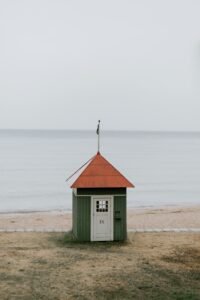Things to consider when looking for the best outdoor sheds

Best Outdoor Sheds: Enhance Your Outdoor Living Space
Imagine having all your gardening tools neatly organized, your outdoor furniture protected from the elements, and extra storage space for all your outdoor gear. That's where outdoor sheds come in handy. Whether you're a gardening enthusiast, DIY hobbyist, or just need extra storage space, investing in the best outdoor shed can transform your outdoor living experience. In this guide, we'll explore everything you need to know about outdoor sheds, from types and benefits to maintenance tips and popular brands.
1. Introduction to Outdoor Sheds
What are outdoor sheds?
Outdoor sheds are standalone structures typically located in a backyard or garden area. They provide additional storage space for gardening tools, lawn equipment, outdoor furniture, and more. These versatile structures come in various sizes, styles, and materials to suit different needs and preferences.
Importance of outdoor sheds

Outdoor sheds play a crucial role in keeping outdoor spaces organized and clutter-free. They not only provide storage solutions but also enhance the aesthetic appeal of your property. Additionally, outdoor sheds can increase the overall value of your home by adding functional space and improving curb appeal.
2. Types of Outdoor Sheds
When it comes to outdoor sheds, there are several types to choose from, each with its own set of features and benefits.
Metal sheds
Metal sheds are known for their durability and low maintenance requirements. They are resistant to rust, corrosion, and pests, making them ideal for outdoor storage. Metal sheds come in various sizes and designs, offering ample space for storing tools, equipment, and other items.
Wooden sheds
 Wooden sheds are popular for their natural aesthetics and versatility. They blend seamlessly into outdoor surroundings and can be easily customized to match your home's design aesthetic. Wooden sheds require regular maintenance, including staining or painting to protect against moisture and rot.
Wooden sheds are popular for their natural aesthetics and versatility. They blend seamlessly into outdoor surroundings and can be easily customized to match your home's design aesthetic. Wooden sheds require regular maintenance, including staining or painting to protect against moisture and rot.
Plastic sheds
Plastic sheds are lightweight, durable, and easy to assemble. They are resistant to rot, rust, and pests, making them a low-maintenance storage solution. Plastic sheds come in a variety of sizes and styles, offering ample storage space for gardening tools, bikes, and other outdoor gear.
3. Factors to Consider Before Buying
Before purchasing an outdoor shed, there are several factors to consider to ensure you choose the right one for your needs.
Size and space
Consider the amount of space available in your backyard or garden area and choose a shed size that fits comfortably within that space. Take into account the items you plan to store and ensure the shed provides enough room for easy access and organization.
Durability and material
Select a shed made from durable materials that can withstand outdoor elements such as rain, wind, and UV exposure. Consider factors such as maintenance requirements, resistance to pests and rot, and longevity when choosing between metal, wood, or plastic sheds.
Budget
Determine your budget and research sheds within that price range. Keep in mind that while upfront costs may vary, investing in a high-quality shed can save you money in the long run by reducing maintenance and replacement expenses.
4. Benefits of Having an Outdoor Shed
Outdoor sheds offer a wide range of benefits beyond simple storage solutions.
Storage solutions
An outdoor shed provides a designated space to store gardening tools, lawn equipment, outdoor furniture, and other seasonal items, keeping them organized and easily accessible when needed.
Organization
By having a dedicated storage space, you can keep your outdoor area tidy and clutter-free, creating a more enjoyable environment for relaxing, entertaining, and gardening.
Increased property value
Adding an outdoor shed to your property can increase its overall value by providing additional functional space and enhancing curb appeal. Potential buyers may see the shed as a valuable asset, especially if it's well-maintained and complements the existing landscape.
5. Popular Brands in the Market
When shopping for an outdoor shed, it's essential to research reputable brands known for their quality and reliability.
Shed brands comparison
Compare popular shed brands based on factors such as material quality, design options, warranty coverage, and customer reviews to make an informed decision.
6. DIY vs. Pre-built Sheds
Deciding between a DIY shed kit and a pre-built shed involves weighing the pros and cons of each option.
Pros and cons of each
While DIY shed kits offer customization options and potentially lower costs, pre-built sheds are convenient and require minimal assembly. Consider your skill level, time constraints, and budget when choosing between DIY and pre-built sheds.
7. Maintenance Tips for Outdoor Sheds
To keep your outdoor shed in top condition, regular maintenance is essential.
Cleaning and upkeep
Regularly clean your shed inside and out to remove dirt, debris, and moisture buildup. Perform routine inspections for signs of damage or wear and address any issues promptly to prevent further damage.
8. Creative Uses for Outdoor Sheds
Beyond storage, outdoor sheds can serve a variety of creative purposes.
Home office
Transform your shed into a home office or creative studio, providing a quiet and inspiring space to work or pursue hobbies.
Workshop
Create a workshop in your shed equipped with tools and workbenches for DIY projects, woodworking, or crafting.
Gardening space
Use your shed as a dedicated gardening station with shelves, potting benches, and storage for seeds, pots, and gardening supplies.
9. Environmental Impact of Outdoor Sheds
Consider the environmental impact of outdoor sheds and opt for sustainable options when possible.
Sustainable options
Choose sheds made from eco-friendly materials such as reclaimed wood or recycled plastics to minimize environmental impact. Additionally, consider installing rain barrels or solar panels to reduce energy consumption and water waste.
10. Safety Measures for Outdoor Sheds
Ensure your outdoor shed is safe and secure for both your belongings and your family.
Securing against theft
Install locks, alarms, and security cameras to deter theft and vandalism. Consider reinforcing doors and windows with additional locks or bars for added security.
Safety for children and pets
Store hazardous materials such as chemicals, pesticides, and sharp tools out of
reach of children and pets. Secure heavy items and shelving to prevent tipping or collapsing accidents.
11. Customer Reviews and Testimonials
Before making a purchase, read customer reviews and testimonials to learn about others' experiences with specific shed brands and models.
Real-life experiences
Gain insights into shed performance, durability, customer service, and overall satisfaction from real-life experiences shared by other customers.
12. Frequently Asked Questions (FAQs)
What size shed do I need?
How much does a shed cost?
Can I customize my shed?
Are outdoor sheds weatherproof?
Do outdoor sheds require a foundation?
Conclusion
Investing in the best outdoor shed can enhance your outdoor living space, providing storage solutions, organization, and additional functionality. Consider factors such as shed size, material, and budget when choosing the right shed for your needs. With proper maintenance and care, your outdoor shed can be a valuable asset for years to come, adding both practicality and aesthetic appeal to your property.
FAQs (Frequently Asked Questions)
What size shed do I need?
Determining the size of shed you need depends on the amount of space available in your outdoor area and the items you plan to store. Measure your available space and consider the dimensions of the shed to ensure it fits comfortably and provides enough storage capacity.
How much does a shed cost?
Shed prices vary depending on factors such as size, material, design, and brand. Basic sheds can range from a few hundred dollars to several thousand dollars for larger or more customized options. Consider your budget and research different shed models to find one that fits your needs and price range.
Can I customize my shed?
Many shed manufacturers offer customization options, allowing you to choose features such as size, color, roof style, and accessories to suit your preferences. Some companies may also offer additional customization services for a fee, allowing you to create a shed that meets your specific requirements.
Are outdoor sheds weatherproof?
While outdoor sheds are designed to withstand outdoor elements, their level of weatherproofing depends on factors such as material quality and construction. Metal and plastic sheds are generally more weather-resistant than wood sheds, but proper maintenance and upkeep are essential to ensure longevity and protection against the elements.
Do outdoor sheds require a foundation?
Most outdoor sheds require a stable foundation to ensure structural integrity and prevent shifting or settling over time. Common foundation options include concrete slabs, gravel beds, or pressure-treated wood frames. Consult the shed manufacturer's instructions or a professional contractor to determine the best foundation option for your shed.
- Crafting Affordable Dream Sheds: Cost-Effective Solutions for You
- Affordable Outdoor Storage: Budget-Friendly Shed Alternatives
- Dont Break the Bank: Top Picks for Cheap Shed Options
- Crafting Cost-Effective Solutions: Affordable Shed Construction Explained
- Empowering Your Space: Tips for Managing Shed Construction Budget
- Unveiling Shed Building Cost Estimator: Your Budgets Best Friend
- Revamp Your Shed: Creative Shed Base Ideas for Your Outdoor Oasis
- Elevate Your Shed Game: Unveiling the Magic of Concrete Foundations
- Budget-Friendly Solutions: Exploring Prefab Shed Prices
- Step-by-Step Gravel Shed Foundation Building Made Easy

Leave a Reply
You must be logged in to post a comment.